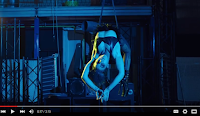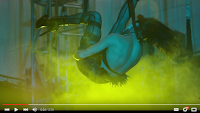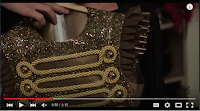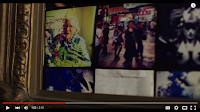Circus girls| Straps; Angelica | (2015)
Produced by; Channel 4
Distributed by; Channel 4
Awards; n/a
This short documentary sticks to the conventional structure. It includes;
-interviews
-soundtrack/incidental (non diegetic) music
-titles and credits
-a range of clips relating to the documentary topic
-changes in the music according to the mood created by the person talking
The mood created in this documentary is very dark and moody. This is created by the soundtrack which starts off quiet, light and moving which then dips into a heavier, driving beat. Most the settings used in the documentary use low key lighting, with filtered blue lighting. Altogether, this creates both a dark and moody atmosphere.
At the beginning of the documentary, there are a range of long shots and medium long shots in which have been edited into slow motion montage of clips, as well as a non-diegetic voice over narrating over the soundtrack. In these clips, there is a girl showing off her skills hanging off high straps. At this point, the soundtrack is quiet and light which works along side the clips making the woman appear to be angelic and swift. These clips have been slowed down to captured the detail in her work so the audience can understand more about the way its done. These clips, without the use of the voice-over, tell the audience more to what the documentary is about as a brief insight into what it involves and showing off what it is.

Long Shot, low key lighting with filtered lighting
The last clip in the montage sequence is then edited so the titles appear over the top of the clip but the clip is still in motion. The titles appear in big, blocked letters, which conventionally would expected to be seen on a circus poster as to attract the attention of the audience and to make it seem big and exciting.

Long shot, low key lighting
Title screen using long shot from previous shot
After the title screen, there are more montage clips showing the girl showing off her skills and tricks with the straps. This involves more long shots, a range of close ups and medium close ups. These shots use the same lighting from the previous shot and the same voice over. The pace of the editing is much quicker in this montage, in which the shots are a lot shorter and the music is more driving and faster which reflects on her energy and concentration on the ropes.
After these montage clips, the editing cuts to a medium long shot in a different location. This location uses high key, bright lighting and the non diegetic soundtrack fades a little and becomes a lot calmer and less driving. the mes en scene shows the woman in a different location with a collage of imagery in the background with skulls and punk art which reflects on her culture and character as a person. This shot is still and motionless and is longer than the other shots, in which this is the shot positioning they have used for interviews.
MCU, interview
The camera then cuts to different location, and shows a medium close up of the woman, who to the side of the shot. In the centre of the frame, there is an outfit, in which the woman is reaching out to. The importance of this is that by having the costume in the centre of the shot, it shows the significance of it for the woman and for the documentary. The camera then tracks the subject (the woman) in which the duration of the shot the woman is voicing over (non-diegetic), in which the audio is being used from the interview in the previous shot. The non-diegetic soundtrack at this point is still calm and quiet, and the camera then cuts to a close up of the outfit she is holding up, which confirms that she has a significant connection with this item of clothing.
MCU, outfit centre of shot

CU, outfit
Another shot then shows another costume piece in the centre shot (mid shot) with the girl at the side of the shot, which again shows the significance of the outfit piece as it it placed in centre frame. This confirmed in the next shot which shows a mid shot of the woman wearing the outfit piece, followed by another mid shot with the outfit piece in her hand, and the woman talking to the camera (diegetic sound) about it in which the audio has been lapsing over the previous shot so the voice over was non diegetic. All the while the non diegetic soundtrack is playing in the background, setting a mysterious yet calming atmosphere.
The camera then cuts to a close up of the woman, giving indirect mode of address to the camera. The soundtrack is unchanging and bridges over from the previous shot to the new shot location, in which the voice over is diegetic. The camera then cuts to a close up of a photograph, which matches with the eyeline match. This use of editing tells the audience the woman has a connection with the photograph, which is confirmed in the dialogue when the woman says "This is my grandma" which further tells the audience about the personal connection with the photograph. Further evidence of this can be found in the following shot, where the camera cuts into a big close up of the photograph to emphasis the importance of the photo.

CU, high key lighting

CU, eyeline match
The camera then cuts to a long shot to a different (outdoor) location, in which there is higher key lighting and the soundtrack (non-diegetic) becomes softer and more calming. The soundtrack changes as the story being told by the voice over goes on to explain her grandmas death, in which the soundtrack becomes softer and calming to emphasise the sadness in her situation and the pace of the editing is also a lot slower.This shot is followed by a small montage of close ups showing photographs from the background in the first shot of the interview;

CU, part of montage
At the end of the montage, there is a mid shot of the woman giving direct mode of address in a low key lit location. This helps to create a darker mood set by the non diegetic soundtrack and the topic being discussed by the voice over (non diegetic). As the voice over starts a new topic, the incidental music changes from calming vibes to more driving and motivated tone. A new montage starts up showing different shots of close ups of different parts of her body, using low key lighting and the editing speeds up to match the pace of the non diegetic soundtrack. the montage also includes a long shot of the woman preparing the straps, whilst the non diegetic voice over plays in the background. The camera then cuts back to the medium close up of the woman being interviewed, and then back to the montage of clips showing close ups of the woman getting ready to practice on the ropes.
The editing then fades out to show the end of the collection of clips, and fades in to show slow motion footage of close up of hands, in which then cuts to a medium long shot of the hands in motion from the previous shot, creating an action match. The lighting is low key but uses bright coloured filters, in which is continuously used throughout the montage. The montage consists of slow motion footage to express her elegance and skills on the rope and consists of long shots and closeups to show the action from different angles and perspectives. The voice over bridges the clips in the montage and the non diegetic soundtrack continues to be driving and energetic to emphasis her motivation and skill. The last shot shows a low angle shot of the woman hanging from the ropes, and uses lowmkey lighting, in which the camera fades and cuts to the title screen, which uses the same font colour and style as the intro.



No comments:
Post a Comment